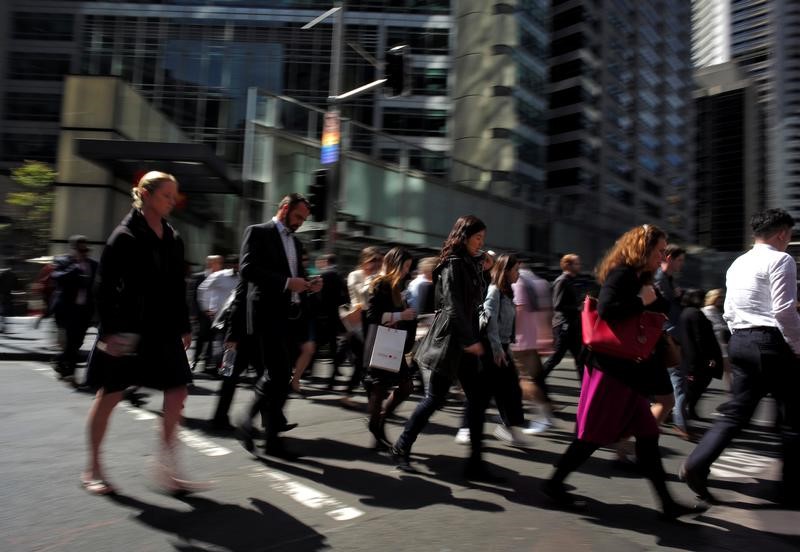 © Reuters. Office workers and shoppers walk through Sydney’s central business district in Australia
© Reuters. Office workers and shoppers walk through Sydney’s central business district in AustraliaBy Swati Pandey and Wayne Cole
SYDNEY (Reuters) – Women coming into Australia’s workforce provide the answer to an economic puzzle that analysts and policymakers alike have been struggling to solve this year.
While the country’s employment has been surging beyond all expectations, the jobless rate hardly budged.
The explanation seems to be that tax breaks on childcare and the launch of a disability insurance scheme have prompted a surge in new jobs in the healthcare sector in roles dominated by women.
The result is that the proportion of women in the workforce has reached a record high of 60 percent, which analysts say is a big positive for the economy.
But the optimism is tempered shorter-term by the fact that most other sectors of the economy have seen limited or no jobs growth this year.
New jobs rose 2.7 percent in the year to August, the latest quarterly figures from the Australian Bureau of Statistics (ABS) show, much faster than the 1.6 percent growth in the population. Still, unemployment stuck at around 5.6 percent.
A Reuters analysis of the data shows that more than a third of the 329,000 net jobs created in Australia in the year to August were in healthcare, outstripping even the booming construction industry.
Annual jobs growth in healthcare was a scorching 8.7 percent, and it is easily the single biggest employer with 1.6 million workers, ahead of retail and construction.
Childcare and social assistance make up the bulk of the new jobs, a breakdown of the healthcare data shows, both sectors where women tend to be active participants. And as they enter the workforce, many in turn are hiring carers for their own children, thus creating more jobs.
The upsurge in healthcare has happened relatively recently, and corresponds closely to the timing of tax breaks for childcare and the launch of a government-mandated, tax-payer funded National Disability Insurance Scheme (NDIS).
Healthcare created just 4,000 new positions in the 12 months to August 2016. But in the six months to last August, it added 106,000 and the figures are set to rise.
The federal government estimates that demand for care providers due to the NDIS will double to 163,000 full-time equivalent positions in 2020 from 73,000 in 2013.
The shift to more care workers is one that more rich nations will have to consider as populations age. And, like in Australia, increased participation in the workforce by women is vital to counter shrinking working-age populations.
The proportion of men in the workforce in Australia, for example, has been in long-term decline and is currently at 70.7 percent, down from above 79 percent in 1978.
“Rising female participation in the economy is good for growth as it will boost the workforce and a more gender diverse workforce is good for productivity,” said Shane Oliver, head of investment strategy at AMP Capital.
LESS IMPRESSIVE?
However, the increase in the overall jobs numbers this year is not as flattering for the economy as the headline figures might suggest, analysts said.
Just three of 19 industry sectors – healthcare, construction, education – accounted for the vast bulk of the job gains this year, illustrating how narrowly based the revival has been.
That has left some slack in the labor market, which is restraining wage growth and consumer prices and keeping the central bank from lifting record-low interest rates of 1.50 percent.
“The 2017 acceleration in aggregate employment all but disappears in the ex-healthcare numbers,” said JP Morgan analyst Ben Jarman.
“Employment growth in the cyclical, bellwether sectors such as manufacturing, real estate or retail remains less impressive. This suggests recent strong employment has minimal implications for unemployment or wage growth.”
Source: Investing.com


























